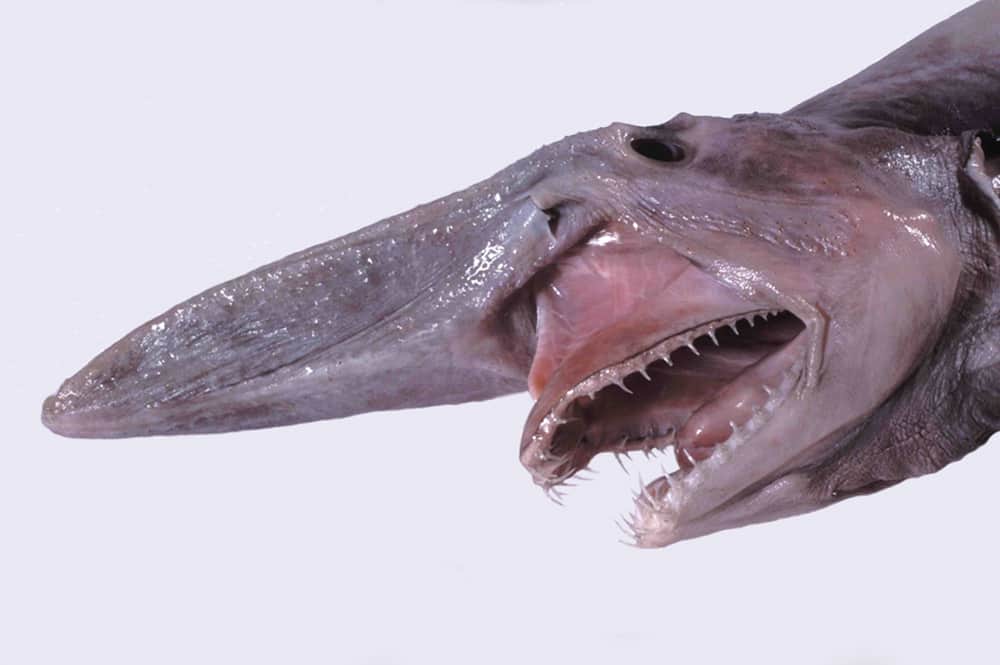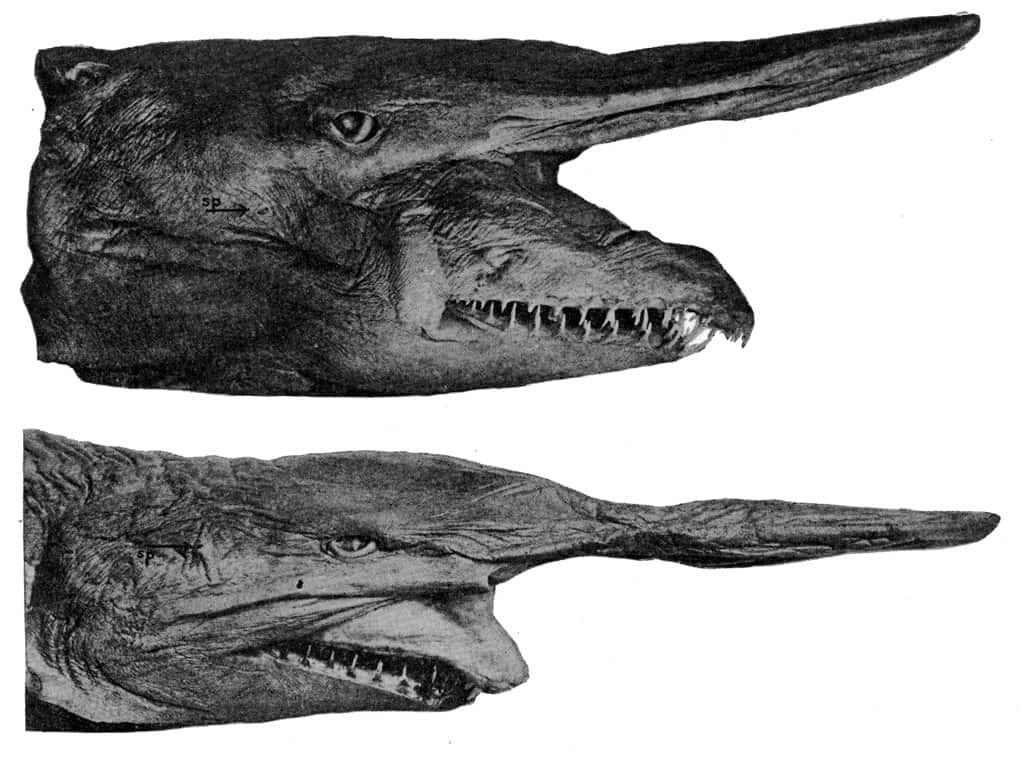
The ocean’s a weird place full of bizarre but fascinating creatures — the goblin shark is definitely one of them. The goblin shark is probably the most unusual type of shark in the world. Deep down the water column, at roughly 1000 meters deep, where sunlight barely passes through, the goblin shark roams.
Picture a shark. Great white, maybe? Now forget that image. A goblin shark looks nothing like its more famous cousins. It’s pink-skinned, not gray. It has a long, blade-like snout. But its jaw—that’s the real showstopper. This shark can extend its jaw out of its mouth in a flash, like a horror movie villain.
Seriously, the goblin shark has an innately creepy ability to completely unhinge their jaws; this shark is the stuff of nightmares — and yet you shouldn’t be afraid of it. Here’s why.
Goblin Shark Description
Goblin sharks are old. Very old. The species has been around for approximately 125 million years. That means their ancestors shared the ocean with dinosaurs. Being a “living fossil” isn’t just a catchy phrase — the goblin shark is a biological marvel. It means they’ve survived mass extinctions, climate shifts, and countless other challenges over millions of years.
When you first lay eyes on a goblin shark, its distinct appearance immediately grabs your attention. Its skin has a pinkish hue, almost translucent. The snout is elongated, resembling a blade. And its jaw? The jaw can protrude outwards, making it look like something straight out of an alien movie. Unlike the great white or hammerhead sharks, the goblin shark doesn’t look streamlined or agile. In fact, it seems almost… awkward. But it’s very well adapted to its environment.
Where Goblin Sharks Live and What They Eat

Goblin sharks are deep-dwellers. They absolutely adore open spaces and tend to keep to the edges of continental shelves (the literal submerged edge of a continent) at depths greater than 270 meters. They’re also absolute units. An average Goblin Shark is 12 feet long (3.7 meters). They also weigh a whopping 460 pounds (208.6 kilograms). They’re not the biggest of sharks, but they’re definitely not small fry either.
Goblin sharks primarily feed on deep-sea creatures such as fish, squid, and crustaceans. Their unique jaw mechanism allows them to rapidly extend their jaws outward to capture prey. This is particularly useful in their dark, deep-sea environment where swift and precise action is necessary to secure a meal.
How Goblin Sharks Hunt and Reproduce
Unlike the enthusiastic protagonists of Jaws, goblin sharks aren’t super fast. In fact, they’re lousy swimmers. Factor in their size, speed, and the fact that they live in very open and expansive waters, these fish aren’t built for chasing prey. Instead, goblin sharks use their extended snouts — in particular, specialized organs called the Ampullae of Lorenzini that detect electrical currents from prey — to detect prey using electric fields.
When a goblin shark senses a potential meal nearby—often using electroreceptors that detect the electrical fields produced by other marine animals—it can thrust its jaw forward in a fraction of a second to snatch the prey. The jaw is filled with long, pointed teeth that are ideal for gripping slippery, deep-sea inhabitants. Thi ruthless hunting tactic of engulfing the prey along with the water that surrounds it is known as ram-feeding, a form of ambush predation.
These animals aren’t pack creatures either. So far, we don’t really know of any animals that hunt down these sharks. So, the whole “safety in numbers” shtick doesn’t really make any sense to them. Rather, these sharks, like Great Whites (although interestingly enough, great whites do have natural predators!) prefer living and hunting alone. As for their mating habits, not a lot is known about the behaviors of goblins so we don’t know much beyond their solitary nature and their feeding tactics.
Why are Goblin Sharks called Goblin Sharks?
Goblin is a bit of a misnomer when it comes to these creatures. Chances are, when you think of goblins — you think of tiny and small intrepid green creatures yet goblin sharks are quite literally the opposite.
They’re not green and lithe, either. Rather, they’re pink and massive. This is because goblin sharks aren’t really named after goblins…these sharks are actually named after tengus (tenguzame), a different mythical creature sometimes approximated through a goblin.
The first Goblin sharks were spotted off the coasts of Japan. Here, Goblin sharks were named after tengus, a mythical and legendary being famous in Japanese lore for their long, beaklike noses. This Japanese name, tengu, when translated to English yielded the current nomenclature of the shark-goblin.
Adaptations and survival in extreme environments
Goblin sharks have a pretty poor sense of sight. This makes sense once we consider the depths of their mesopelagic habitats, barely any light even penetrates water after the 200 meters threshold. So, like most other mesopelagic and pelagic sharks, goblins depend on their Ampullae of Lorenzini, electroreceptors on their snouts, to navigate their surroundings.
They’re also very lazy swimmers. They don’t zip up and down the depths of the water column, running after prey. Instead, these sharks are only active in either the mornings or evenings – when they sit and wait for the movement of migratory fish on which they feast. They’re even known to use their extended rostrum – snout – to dig up sand from the seabed to search for hidden prey like small molluscs and crustaceans.
Goblin Shark Facts
- It isn’t just that goblin sharks can literally whip put their jaws, what’s crazier still is the speed at which they do it. Goblin sharks have the fastest jaws of any known species of fish in the sea!
- They’re also truly one of a kind. Goblin sharks belong to the Mitsukurinidae family, of which they’re also the only extant member. The Mitsukurinidae family is also fairly ancient. That makes these sharks living fossils – they have a storied lineage dating back over 125 million years. That’s in the range of the Early Cretaceous!
- Surprisingly enough, these ancient giants have a light-pinkish coloration!
- From cephalopods like cuttlefish, octopi, and squid to crustaceans like crab and lobster, goblins have a pretty varied roster of a diet.
- True to their mysterious and legendary nomenclature, goblin sharks are a very rare sight. In fact, it was just as recent as 2018 that a team from the Japan Broadcasting Association caught the first ever video footage of their feeding behavior.
- Apart from continental shelves, these sharks also love the open expanses of mesopelagic seamounts.
Recent studies on goblin sharks
Research on Goblin Sharks is few and far between. As a matter of fact, although these fish have been spotted in the waters of the Atlantic, Pacific, and Indian Oceans – we still haven’t been able to establish their exact home range! A recent win for Mitsukuri shark literature came about in 2020. A second confirmed record of their range in Indonesian waters helped fill long-standing gaps in their distribution literature.
The last big update on the Goblin Shark came from Hokkaido University, Japan. Emeritus Professor Kazuhiro Nakaya and his research team studied the feeding mechanisms of the Goblin Shark. Nakaya and his team studied video footage of goblin sharks feeding to analyze their biting process. The team concluded from video footage captured by public broadcasters NHK that the shark used something they dubbed “slingshot feeding” to capture prey.
Interestingly enough, the team discovered that once the sharks capture their prey, they would reopen and re-close their mouths again when rescinding their jaws.
Conservation Status
Are Goblin Sharks endangered or rare?
Although rarely sighted, Goblin sharks aren’t an endangered species. The IUCN lists them as a Least Concerned species. Still, the more complete answer is that we’re not really sure.
Currently, it’s hard to say whether goblin sharks are endangered. They don’t show up often enough to count. But that doesn’t mean they’re safe.
Threats to Goblin Sharks
Despite having no known predators, goblin sharks still encounter a bit of danger deep under the sea. Reports and records of Goblin Shark captures from Japan, Indonesia, and Taiwan reveal their vulnerability to deepwater fisheries activities. Similarly,although not actively “on the market”; these sharks’ jaws are also highly in demand and subject to attention from private collectors.
Deep-sea trawling and other fishing activities can unintentionally capture these sharks. While they aren’t directly targeted, their accidental capture tells us we’re reaching into even the most remote corners of our planet. And that comes with risks, not just for goblin sharks, but for the whole delicate balance of deep-sea life.
Conservation efforts
Currently, due to a lack of tangible research and information – there are no actual species-specific management plans in place to conserve goblin sharks.
Are goblin sharks dangerous (to humans)?
Goblin sharks pose absolutely no threat to humans. In fact, there are actually zero records of a Goblin Shark attack! There are several reasons why you should actually not be afraid of these sharks at all.
First, they inhabit depths of the ocean that are far beyond the reach of most recreational divers, typically ranging from 890 to 3,150 feet deep. This makes human encounters with goblin sharks extremely rare.
Second, goblin sharks are not built for speed or agility like other, more aggressive shark species such as great whites or tiger sharks. Their bodies are softer and flabbier, indicating a lifestyle suited to slow cruising in deep waters rather than rapid, aggressive action.
Lastly, their diet primarily consists of deep-sea fish, squid, and crustaceans. They are not known to eat large mammals, and their method of feeding is specialized for capturing smaller, slippery prey rather than taking large bites out of bigger animals. So, if you’re worried about encountering a goblin shark during your next ocean swim, you can put those fears to rest. The likelihood is extremely low, and even if such an encounter were to happen, the goblin shark is not considered to be a significant threat to humans.
Goblin Shark Videos
The bottom line on goblin sharks
The ocean is a weird place but not all that’s weird in the ocean is actually a threat. Tons of marine animals like Goblin Sharks just keep on swimming (And minding their business) deep under the sea.
In fact, Goblin Sharks are so good at keeping to themselves that in spite of their 125 million-year-long lineage, we barely know a thing about them!
Habitat also plays a big part in this. Like most mesopelagic animals, goblin sharks will have an air of mystery to them because it’s just so logistically tough to study them.
It’s not all sad for Goblins though as whatever little we do actually know of them, is veritably super cool. For instance, goblin sharks have the fastest jaws of any fish in the sea, they’ve pretty much been unchanged from the time of the dinosaurs, and they’re named after tengus – supernatural or godlike mythical creatures from Japan. That’s a pretty solid reputation for any fish.






